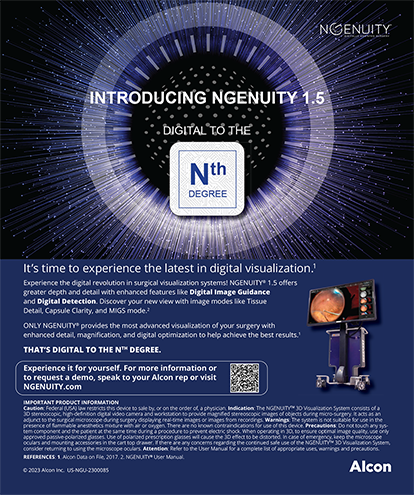When I (TK throughout article) was asked to contribute an article for this column, I thought about the most difficult cases I have encountered to date as a cataract and refractive surgeon. I decided to present this case from a few years ago for a number of reasons, the most important being the lessons that I learned.
PATIENT'S HISTORY
A well-respected glaucoma specialist referred a very pleasant 82-year-old white woman with a history of severe glaucoma to me for an evaluation for cataract surgery. This same specialist had previously referred several of his relatives to me for cataract surgery. From her daughter, I learned that the patient, the matriarch of a large extended family, still actively maintained her home but that she was struggling to perform her most cherished activity of cooking big meals for her family and friends on Sunday afternoons after church services.
More than 25 years earlier, the patient had undergone two laser peripheral iridotomies (LPIs) for an anatomically narrow angle in her right eye. She had also undergone extracapsular cataract extraction (ECCE) in her right eye without IOL implantation due to complications that occurred during the procedure. She subsequently lost all light perception from glaucomatous optic atrophy in that eye. In her left eye, she underwent two superior LPIs for a narrow angle and later developed a dense brunescent cataract. The patient's BCVA in her left eye with 6.00 D of spherical correction had decreased to hand motions.
CLINICAL FINDINGS
On examination, the IOP in the patient's left eye measured 14 mm Hg. The two superior LPIs were patent, and the anterior chamber angle was very shallow (1.8 mm). The iris did not show signs of neovascularization but expanded to only 3 mm after the instillation of mydriatics in the clinic. The left eye had a grade 4+ nuclear sclerotic brown cataract. I could not perform a fundus examination due to the density of the cataract. Results of B-scan ultrasonography were normal. The axial length of the left eye was 20.2 mm. Based on these clinical findings, I made a mental and written note that a pars plana vitrectomy might be necessary to deepen the anterior chamber and that a pupillary expansion device might be required. I also noted the potential for a conversion to an ECCE.
I had a lengthy discussion with the patient and her daughter regarding observation versus surgical intervention. I explained the potential complications of surgery. I emphasized the possibilities of corneal endothelial decompensation, which would possibly require corneal transplantation, and limited visual acuity due to the patient's advanced glaucoma. Frankly, I was relieved when the patient elected observation. After discussions with her local pastor, however, the patient (and her daughter) returned a few weeks later and elected to undergo cataract surgery on her left eye.
SURGICAL COURSE
After the application of topical tetracaine, I created a temporal clear corneal incision due to the patient's prominent brow and deep-set eye. For this step, I used a 2.2-mm ClearCut SB HP keratome blade (Alcon Laboratories, Inc.). Intracameral buffered lidocaine, epinephrine, and balanced salt solution in a concentration described by the late Joel Shugar, MD,1 were instilled in the anterior chamber through the corneal paracentesis, followed by VisionBlue (DORC International BV). I injected Viscoat (Alcon Laboratories, Inc.) into the anterior chamber to deepen it (without the need for a pars plana vitrectomy) and protect the corneal endothelium. I placed a 6.25-mm Malyugin Ring (MicroSurgical Technology) to further enlarge the pupil. An anterior capsular capsulorhexis was initiated with a bent-needle cystotome and completed without incident using Utrata forceps.
UNDER PRESSURE
With the Ozil IP Torsional Ultrasound on the Infiniti Vision System (Alcon Laboratories, Inc.), I used a horizontal chopping technique to remove the nucleus in situ. Because of the density of the lens and the thick, rubbery, leathery consistency of the posterior plate, routine chopping failed to crack the posterior plate; repeated chopping maneuvers were required to lyse the fibers of the posterior plate (Figure 1). As instructed by my mentors, I periodically interrupted phacoemulsification to reinstill Viscoat to protect the endothelium and help maneuver the dense nuclear fragments into position. After an additional three syringes of the ophthalmic viscosurgical device and an elapsed surgical time of close to 30 minutes, I began to perspire from the physical and mental stress of the case. I also began to contemplate whether I should have converted this case to an ECCE.
BURN BABY BURN (AND IT'S NOT A DISCO INFERNO)
As I was emulsifying the last nuclear fragment, I felt a sudden gush of fluid in my lap and witnessed immediate whitening of the temporal clear corneal wound (Figure 2). I was not experiencing a loss of urinary continence. Rather, the repeated maneuvers of the phaco handpiece, including the multiple entries and exits into/from the anterior chamber, had caused the irrigation port to loosen and fall off the phaco handpiece, resulting in a corneal wound burn.
SOUNDS OF SILENCE
With the exception of the rhythmic beeping of the cardiac monitor (which would have been beeping much more rapidly if the monitor had been on me), the OR was silent as I proceeded to remove the cortical material and the Malyugin Ring and implant a single-piece acrylic 29.00 D IOL in the capsular bag without complication.
For the next 30 minutes, I tried in vain to close the corneal wound. This was the first phaco wound burn I had ever encountered, and I quickly learned how difficult a 2.2-mm incision can be to close. I did not have access to the techniques recommended by Robert H. Osher, MD, for radial and horizontal suturing of a gaping wound; nor did I have access to lamellar tissue for patch grafting.2,3 I therefore tried multiple times to place radial and cross-stitched sutures with 10–0 nylon. My attempts ultimately failed to completely close the wound (Figure 3). Finally, I opted to keep one radial suture and one cross-stitch in the wound and applied Dermabond cyanoacrylate adhesive (Ethicon Inc.) over the sutures to close the wound (Figure 4). A 20-mm bandage contact lens was then placed over the eye.
OUTCOME
On postoperative day 1, the patient's UCVA was 20/400 with approximately 7.00 D of corneal astigmatism. The bandage contact lens was removed, and testing of the temporal wound was Seidel negative. The cornea had 3+ edema with 3+ Descemet membrane folds, the anterior chamber was formed, and the PCIOL was well centered in the capsular bag. The patient's corneal edema slowly improved with aggressive topical corticosteroid therapy, which included difluprednate ophthalmic emulsion 0.05% (Durezol; Alcon Laboratories, Inc.) and eventual tapering to loteprednol suspension 0.5% (Lotemax; Bausch + Lomb) over the few months that followed. Using forceps, I removed the Dermabond and corneal sutures at the slit lamp 6 months after surgery. The patient's corneal astigmatism gradually decreased to approximately 4.00 D, and her quality of vision continued to improve.1 Thankfully, her IOP remained stable, and corneal transplantation was not required. My patient and I (along with her referring physician) were thrilled that she was able to resume cooking and other daily activities that she enjoyed.
LESSONS LEARNED
Despite the innovative advances in phaco technology, wound burns can still occur. I learned to consider ECCE rather than to assume that phacoemulsificaton is the best procedure in cases of an extremely dense brunescent cataract. Now, I make sure that the connections on all instruments are secure (eg, I/A ports to the phaco handpiece, cannulas on a luer lock syringe, etc.). I also always have cyanoacrylate glue (eg, Dermabond or Histoacryl Topical Skin Adhesive [TissueSeal, LLC]) readily available in the OR and clinic.
Section Editor David F. Chang, MD, is a clinical professor at the University of California, San Francisco, and is in private practice in Los Altos, California. Dr. Chang may be reached at (650) 948-9123; dceye@earthlink.net.
Terry Kim, MD, is a professor of ophthalmology at the Duke University School of Medicine, and he is the director of ophthalmology fellowship programs and associate director of the Cornea and Refractive Surgery Services at Duke University Eye Center in Durham, North Carolina. He is a consultant to Alcon Laboratories, Inc.; Allergan, Inc.; Bausch + Lomb; IOP Ophthalmics; Ista Pharmaceuticals, Inc.; Ocular Systems, Inc.; Ocular Therapeutix, Inc.; PowerVision, Inc.; and SARcode Bioscience. Dr. Kim may be reached at (919) 681-3568; terry.kim@duke.edu.
Matthew D. Kuhnle, DO, is a Captain (P), Medical Corps, United States Army, and a clinical associate at Duke Eye Center in Durham, North Carolina. He acknowledged no financial interest in the products or companies mentioned herein. Dr. Kuhnle may be reached at matthew.kuhnle@duke.edu or matthew.kuhnle@us.army.mil. The views and opinions represented in this article are those of the authors and not the Department of Defense or US Army.


